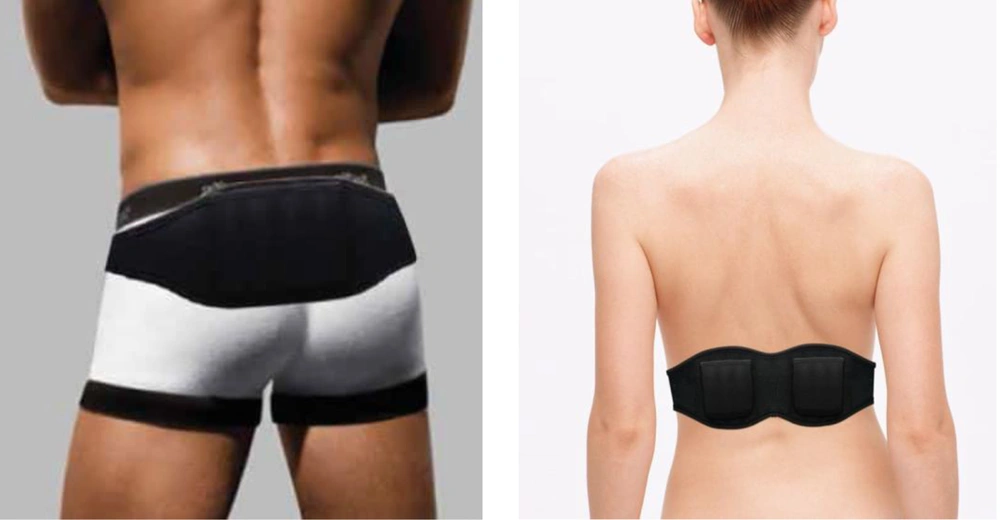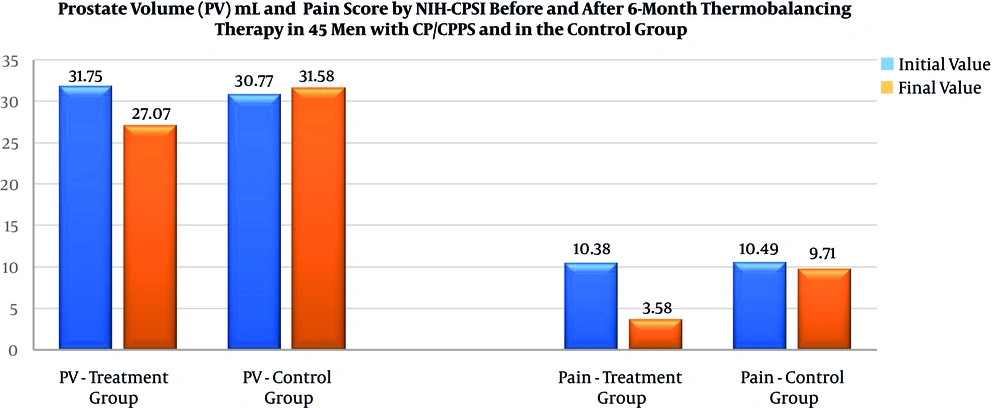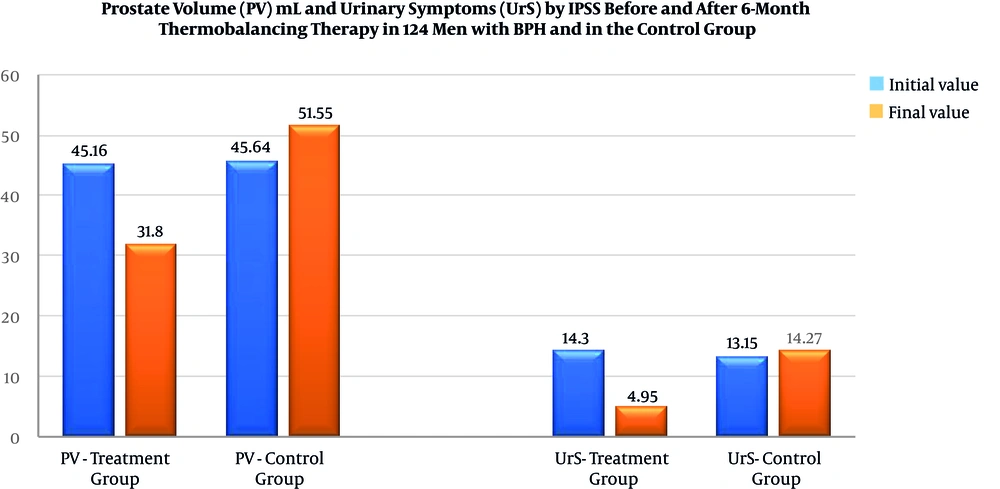1. Background
1.1. Prevalence
Chronic prostatitis/chronic pelvic pain syndrome (CP/CPPS) is the most common disease of the prostate gland in men under 50 that reduce their quality of life. However, the optimal treatment for chronic prostatitis is not possible yet due to the unknown etiology of the diseases (1, 2).
Lower urinary tract symptoms (LUTS) secondary to benign prostatic hyperplasia (BPH) most often encountered in men over the age of 50 and the mild symptoms can be found in 75.3% of men (3). The prevalence of BPH in Iran is less, about 36% in those > 70years (4).
The incidence in kidney stone disease rises in the last decade worldwide with rates ranging from 7 to 13% in North America, 5% - 9% in Europe, and 1% - 5% in Asia (5). The prevalence of kidney stones in Iran is 5.7%. The average cumulative recurrence rate was 16% after 1 year, 32% after 5 years, and 53% after 10 years, which is very important in terms of recommended treatment options for these people (6).
1.2. Standard Treatment Options
Pharmacological interventions and alternative management strategies for CP/CPPS are subject of serious analysis as none of treatment option is effective (7).
Medical and surgical treatments available for BPH have sexual side effects that can negatively affect a patient’s quality of life that is important for physicians to discuss with their patients before initiating treatment. Alpha blockers relax the bladder muscles, making it easier to urinate but cause tiredness, headaches, dizziness and others. 5 alpha reductase inhibitors, such as Finasteride and Avodart act at the hormonal level easing urination but cause impotence, depression, testicle pain, and even diabetes. (8).
Extracorporeal shock wave lithotripsy (ESWL) for kidney stones have usual side effects such as bleeding, pain, and urinary tract infections, and rare complications spleen rupture or intrarenal hematoma (9, 10). The long-term adverse medical events after ESWL are high blood pressure and diabetes mellitus (11, 12). Surgical procedures on kidneys are not safe.
Though percutaneous nephrolithotomy (PCNL) is a minimal access surgery, yet it may have many devastating and life-threatening complications. Postoperative fevers occur transiently in 30% of patients undergoing PCNL, while sepsis may develop in 3% of cases. Injury to the renal collecting system occurs in 8% of patients. The rate of pleural injury after PCNL reaches 1%; and adjacent solid organs are also at risk of injury. The incidence of residual stones after PCNL ranges from 10% to 60% (13, 14).
1.3. Debates About Other Treatments.
Many people with CP/CPPS, BPH and kidney stone disease are not satisfied with conventional treatment options and they try alternative therapies: diet and lifestyle modifications, phytotherapy, acupuncture, myofascial physical therapy, and psychosocial factors (15-17). The symptoms CP/CPPS can worsen from spicy food, coffee, alcoholic beverages, while other nutrients, such as psyllium, water, herbal teas, and polycarbophil, can improve condition of patients with this disorder (18). The use of diet is now considered between the important factors affecting prostate health, particularly in the aging male with BPH (19). The similar view that nephrolithiasis is associated with metabolic syndrome is widely discussed (20). However, none of these methods showed proven effectiveness.
1.4. What is Suggested Here?
Although BPH, kidney stone disease and chronic prostatitis have troubling symptoms, they are non-life-threatening conditions. Therefore, these chronic internal diseases should be treated therapeutically in the first place.
Thermobalancing therapy (TT) with Dr Allen’s therapeutic device (DATD) were developed for the treatment of chronic internal diseases naturally by the long-term application of a source of energy that does not exceed the normal body temperature (21). This therapy has demonstrated pain relief and improvement of quality of life (QoL) in men with CP/CPPS (22, 23). TT with DATD is diminishes LUTS due to BPH, by reducing the enlarged prostate volume (24, 25). The use of DATD in people with kidney stones for over 10 years established its ability to dissolve kidney stones (26).
1.5. Etiology and Pathophysiology
TT is based on a new understanding of The origin of diseases. The etiology and pathophysiology of CP/CPPS, BPH and kidney stones can be explained by changes in small blood vessels in the affected tissues, namely the pathological activity of capillaries. In response to initial triggers-such as inflammation, cold, stress and other factors, the constriction of capillaries follows (27) that creates the focus of hypothermia, the secondary irritating trigger, that leads to spontaneous expansion of a capillary net (28). Slowly expanded capillaries form an extra tissue creating pressure in the organ, which leads to its malfunction. This pressure inside the tissue is also responsible for the continuous compression of small vessels, which makes the problem chronic (29).
2. Objectives
This article is intended to show that TT with DATD is able to terminate the pathological activity of capillaries, enhancing blood circulation in the affected organs, i.e. in a prostate gland and kidneys. And to demonstrate the importance of the use of TT with DATD in the medical practice in the Primary Health Care system to improve people’s lives.
3. Methods
3.1. Study Protocol
Dr Allen’s Device was registered with the Medicines and Healthcare Products Regulatory Agency in the United Kingdom in 2010, as a class 1 medical device. The class 1 medical device without a measuring function and supplied in non-sterile condition does not require the involvement of a notified body. Thus, it is permitted to use TT with DATD by everyone at home. For ten years DATD was distributed across the world having customers in more than 100 countries. There were not complains about this safe therapy. However, it was decided to conduct clinical trial.
Ethics committee of the Yerevan State Medical University approved the clinical study with TT and DATD. The studies were registered at the World Health Organisation via the German Clinical Trials Register (DRKS).
TT with DATD was used in the clinical controlled study at the Department of Urology of the Yerevan State Medical University.
3.2. Study Design
Two clinical trials were completed. One clinical trial in 124 men with BPH who received TT within 6-month period and their clinical parameters before and after therapy were examined. This information was compared with the control group, i.e. data received from 124 men with BPH who were in watchful waiting stage. Second clinical trial in 45 men with CP/CPPS who received TT within 6-month period and their clinical parameters before and after therapy were examined. This information was compared with the control group, i.e. data received from 45 men with CP/CPPS who did not receive TT.
In patient with BPH was measured International Prostate Symptom Score (IPSS) quality of life. In men with CP/CPPS National Institute of Health Chronic Prostatitis Symptom Index (NIH-CPSI) score. In both clinical studies, prostate volume (PV mL) was investigated. The parameters were compared between groups accordingly.
3.3. Participants
For about 3-year period, 45 males (age < 55 years) with CP/CPPS (NIH category III) and 124 men with LUTS due to BPH, from a total of 226 men were selected for clinical trial with PV < 60 mL were received treatment with Dr Allen’s Device at the clinical trials at the Department of Urology of the Yerevan State Medical University. In the control groups: in 124 men with BPH in watchful waiting, and in 45 men with chronic prostatitis on standard treatment. Patients were selected in conjunction with urologists.
3.4. Evaluation
Baseline evaluations were a full physical examination, medical history, digital rectal examination, serum biochemistry, measurement of prostate-specific antigen and electrolytes, urinalysis, and renal function tests. Evaluations were made at baseline and 6 months after treatment. Dynamics of the symptoms and indicators in each group were assessed at the beginning and end of treatment using NIH-CPSI and IPSS. Ultrasound was used to determine the volume of the prostate gland (PV mL).
Evaluation at baseline shows that characteristics of men were identical between treatment and control groups in the CP/CPPS and BPH studies.
3.5. Statistical Analyses
The independent-samples t-test and paired-samples t-test are suitable only for interval and ratio data, so the Wilcoxon signed-rank test was employed. P < 0.05 was considered significant. Statistical analyses were carried out using SPSS v22 (IBM, Armonk, NY, USA).
3.6. DATD
DATD applies a special mixture of waxes (thermoelement) topically to the projection of affected organ. In men with prostate problems to the coccyx area. In people with kidney stones disease to the projection of kidneys in the back (Figure 1). The thermoelement accumulates the emitted body heat, and turns into a source of energy itself. DATD applies thermoelement tightly to the skin tightly, thereby overcoming the skin barrier and spreading the energy towards the prostate gland or kidneys. It is comfortable to wear these devices.
4. Results
4.1. Prostate Volume (PV) mL and Pain Score in Men with CP/CPPS
There was a significant decrease of PV (mL) from 31.75 ± 7.0 to 27.07 ± 4.5 mL (P < 0.001) and pain score from 10.38 ± 2.53 to 3.58 ± 2.54 (P < 0.001) in the treatment group. In the control group changes were insignificant. These results suggested that TT decreases PV and pain in men with CP/CPPS (Figure 2).
4.2. Prostate Volume and Urinary Symptoms Score in Men with BPH
In the treatment group prostate volume decreased from 45.1 ± 3.9 mL to 31.8 ± 4.1 mL (P < 0.001) and urinary symptoms score decreased from 14.3 ± 3.3 to 4.9 ± 2.7 (P < 0.001). In the control group changes were insignificant or even worse. These results suggest that DATD reduces PV and UrS significantly (Figure 3).
| The Empirical Evidence in Patients with Kidney Stone Disease before and after Wearing DATD for Prolonged Period |
|---|
| Patient A: (Male, 69 years old) |
| Kidney stones in both kidneys, large in left. |
| Renal colic often from 1995. |
| Used DATD periodically from 2000. |
| Renal calculi were dissolved, no renal colic after 2002. |
| Patient B: (Female, 44 years old) |
| Kidney stones history for 20 years. |
| Had renal colic every year. |
| Used DATD from January to May 2016. |
| After 2 weeks pain and other symptoms are gone, until now. |
| Patient C: (Male, 58 years old) |
| Kidney stones history for 30 years. |
| 3cm renal stone, lithotripsies in history, CKD. |
| Used DATD from March to December 2014. |
| 3cm stone was dissolved, kidneys function improved. |
| Patient D: (Male, 41 years old) |
| Was diagnosed with kidney stone Nov 2009. |
| Several renal colic within 5 months. |
| Used DATD from March to December 2010. |
| Some twinges first 2 - 3 months but no recurrences since. |
4.3. Side Effects of Thermobalancing Therapy with DATD
Side effects of thermobalancing therapy with DATD were not observed.
5. Discussion
5.1. Main Findings
The use of TT with DATD: reduces volume of the inflamed prostate and pain score in patients with CP/CPPS dramatically, whereas in the control group changes were insignificant. In men with BPH the size of enlarged prostate has been reduced expressively and, consequently, LUTS relief have been achieved. At the same time, the prostate size in men with BPH in watchful waiting increased and urinary symptoms worsened. QoL in men with CP/CPPS and BPH after using therapeutic device improved significantly. Of course, this improvement in QoL is dependent on the decrease in the size of the inflamed prostate in men CP/CPPS and the reduction in the size of the enlarged prostate in men with BPH after thermobalancing therapy.
10 years empirical evidence have shown the unique opportunity of thermobalancing therapy help people to dissolve kidney stones. Patients with kidney stone disease have dissolved kidney stones without renal colic, side effects and complications. This study presents observations of four patients who have suffered from kidney stone disease for a certain period of time, from 5 months to 30 years. All of them dissolved stones in the kidneys, since they did not have any renal colic after using DATD.
These facts can be explained from the point of view that long-term application of the source of energy to the prostate gland and kidneys treats the underlying cause of these chronic diseases. DADT reduces the size of inflamed or enlarged prostate gland by enhancing blood circulation in the organ that improves its functioning and, consequently pain and urinary symptoms. The same with kidneys. It should be noted that none of patients with kidney stone disease has complained that the device does not help. The presented data confirm that TT should be valuated as an effective independent treatment for these chronic conditions.
5.2. Economic
The importance of this study based on the high incidence rate of CP/CPPS, BPH and kidney stones and the high costs of their treatments. For instance, the annual per person costs of treatment of a man with CP/CPPS in 2007 were estimated as $6534 (30).
The investigation in Europe of annual cost of BPH medical treatment was lowest in the UK about $1000 and highest in Poland approximately $1500 (31).
The annual cost of kidney stone disease in 2000 was approximately $2.81 billion, and with increase of population in 2014 it raised to $3.79 billion, and it is estimated the increase the cost of stone disease by $780 million in 2030 (32).
The use of TT with DATD, with the price for a unit less than $200, would make significant changes in the costs of these common urological diseases.
5.3. Pathogenesis of Chronic Disease Due to Changes at the Vascular Level
Outcomes of the study of TT with DATD in men with CP/CPPS confirm the view that the vascular factor plays the major role in the pathophysiology of this disease (33). It has also been determined that chronic pain, which is a manifesting symptom of CP/CPPS, is a consequence of the problem at the capillary level, namely, the micro-focus of hypothermia, which in turn causes an expansion of the capillary network, and this additional tissue increases the pressure on nociceptors causing pain (34).
In recent years, researchers have suggested that the pathogenesis of BPH may be associated with vascular dysfunction, prostatic hypoxia, pelvic ischemia and elevated pressure in the prostate gland (35-37). The use of DADT by keeping the source of energy, accumulated from the body, in the projection of the prostate gland for a prolonged period, have deactivated micro-focus of hypothermia and spontaneous expansion of capillaries, thereby relieving the pressure in the prostate tissue and reducing the enlarged prostate in size (38, 39). The ability of TT with DATD to dissolve kidney stones can be explained by increased blood circulation in the kidneys. This sheds light on the pathophysiology of the formation of kidney stones due to changes in them at the vascular level.
5.4. Conclusions
TT with DATD can be used as mono-therapy for CP/CPPS, BPH and kidney stones, as they improve patient’s condition without adverse side effects and complications.
DATD treats the cause of chronic diseases by using own human body energy, through innovative TT.
TT with DATD is an economical solution for chronic disease management, as the price is cost-effective compared to various treatment options.
People have a key role in protecting their own health, choosing appropriate treatments and managing long-term conditions.
TT with DATD should be implemented into the medical practice.
TT with DATD can improve people’s lives.
TT with DATD can significantly reduce pressure on the healthcare system.
TT with DATD should be offered to patients and administered by primary healthcare services.



